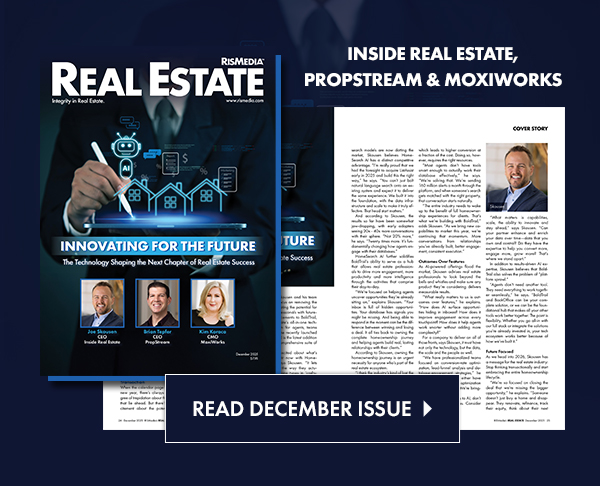Above, CoreLogic Chief Economist Selma Hepp.
Photo credit: AJ Canaria
WASHINGTON D.C.—The economy right now is “weird.” It also might be on the verge of some big changes.
In contrasting, high-profile addresses delivered at RISMedia’s CEO & Leadership Exchange Sept. 5, two of real estate’s most prominent economists gave an audience of top brokers, executives and MLS leaders a break from hearing about the National Association of REALTORS® (NAR) settlement agreement to delve into data that is suggesting the future of housing could look very different from now, or anytime in the past.
“When you look back at 40 years of economic trends by almost every metric, the conditions that we’re in right now are weird,” said Lisa Sturtevant, Bright MLS chief economist. “If you’re going to try and use where we are now to predict where we’re going to go in the future, you’re going to be in trouble.”
Although the recently implemented changes have remained the focus for real estate business leaders—both at the event and across the industry—-Hepp and Sturtevant reminded an audience of top brokers and real estate executives that there are plenty of other factors that are right now affecting their businesses, including data simmering below the surface that points to some big shifts in the real future.
“Waiting for some level of normalization…we are sitting at the first step of that, with the prospect of falling interest rates contributing to some momentum,” said CoreLogic Chief Economist Selma Hepp. “That (momentum) is leading towards unleashing this potential for the housing market in the next few years.”
Hepp and Sturtevant took broadly different approaches, and came to somewhat different conclusions about where the market is headed, illustrating just how unusual the current circumstances are.
What both noted and agreed on was that for almost three years the housing market has lagged, with sales far lower than pre-pandemic levels. And what the near future looks like now, with the positive expectation of rate cuts balanced against massive affordability and inventory concerns.

Sturtevant, for her part, acknowledged that some of her conclusions sounded like the “voice of doom,” but also noted some very positive signs from long-term demographic trends. She also urged individual brokers to emphasize local trends and market status, and not over-rely on national data.
Hepp, who titled her address, “The Good, the Bad and the Ugly,” took a very cautious approach, focused on what trends might return to their pre-pandemic levels, and noted that price appreciation is on track to return exactly to its pre-pandemic level. But she also presented a graph showing just how much pent-up demand is currently bottlenecked by lower inventory and affordability issues, both of which are currently at some of the worst levels in history.
Looking at the number of sales per household (rather than a top-level home sales number, which doesn’t account for population growth), Hepp said there is evidence of significantly more “potential” than what other analyses have shown, as well as a deeper trough in the current environment. The market is currently 1.66 million sales lower than the “potential,” she showed.
That stat fell into the “ugly” category, Hepp said, because it is still unclear exactly when that potential will be unlocked, or what factors will do so.
Sturtevant’s refrain of “weird” carried through to all aspects of her analysis, as she noted that everything from national debt to the difference between locked-in mortgage rates and current rates are in unprecedented territory.
“If you try and use trends from a period we think of as normal to try and predict where we’re going to head in the next 18 to 24 months, you’re also going to be in a bad situation, because people aren’t reacting in expected ways in this weird economy, in this weird housing market,” Sturtevant said.
One very notable trend Sturtevant pointed to was not related to real estate directly—the aforementioned national debt, which is as high as it has been in history. The federal government paying interest on that data indirectly pushes up 10-year treasury yields, she explained, which then keeps mortgage rates higher.
“We’re going to expect mortgage rates to remain relatively elevated, not because of the Federal Reserve,” she said. “Not because of what the Fed does with rates, but because we’re in a new era, where the bond market and the investor market is being driven by what the federal government has to do now to pay the debt.”
Sturtevant also noted that massive price appreciation during the pandemic—which nearly doubled the surge from 2004-2006—is not just going to go away. Affordability, based on these higher home prices, lower wages and elevated rates, is going to be a new sort of challenge.
“Anything that happens…to bring buyers and sellers into the market has to account for the fact that we’re not starting from a place of normality. We’re starting from a place of weird, and so it’s going to take some time for those things to filter through the market,” Sturtevant said.
Locked in and locked out
Another very important and somewhat unprecedented trend is the mortgage lock-in phenomenon, which has seen many homeowners refuse to let go of low fixed-rate mortgages, further limiting transactions. According to Hepp’s analysis, the number of mortgages in the 5.5%-6.5% range has grown to 13.2 million, with 4 million of those originated three years ago or earlier.
Those homeowners could be more likely to sell if rates fall further, as expected, but Hepp said that even more importantly, there is a significant regional variation in mortgage lock-ins that real estate practitioners need to understand. For instance, the average rate in California is below 3.6%, while most southern states—Tennessee, Florida, Texas, Alabama, Arkansas and Mississippi—have an average rate of 4%, meaning those regions could benefit sooner from a drop in rates.
“Markets are really going in different directions at the moment,” Hepp said.
That isn’t the only regional factor, though, according to Hepp. There is a “stronger feeling” of lock-in for people in certain states due to mitigating issues like taxes, which could throw a monkey wrench into the trajectory of transaction growth in places like California, she said.
Sturtevant said that she felt the lock-in issue was “a little overstated,” saying that inventory was beginning to come onto the market at a good pace, headed toward a more healthy level.
But something that both Sturtevant and Hepp fully agreed on is regarding what is almost certainly the biggest issue for buyers—affordability. Sturtevant presented data showing that 75% of agents in Bright’s footprint had a buyer end their home search, the majority because they were unable to find a home they could afford.
Overall, affordability is at its worst point in all of history, measured by median income and median home price, according to Sturtevant. Hepp pointed to the aforementioned issues outside of the home price—insurance costs and taxes—as major concerns for consumers.
Sturtevant provided another shocking and “weird” trend—something that prospective buyers probably would have other words to describe. From 2017 to 2024, the income needed to buy a median-price home doubled, she said, putting homeownership far, far out of reach for a huge proportion of the population.
“This is what buyers are up against, and I don’t want to give away the punchline, but a 25 basis-point drop in mortgage rates isn’t enough to offset (this),” Sturtevant said. “It’s going to be a long haul to work through what we’ve been seeing in the market.”












